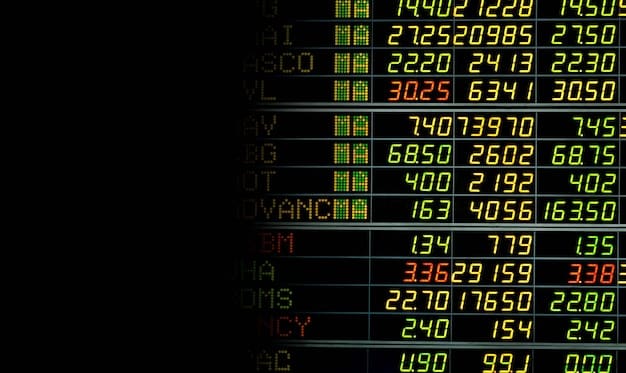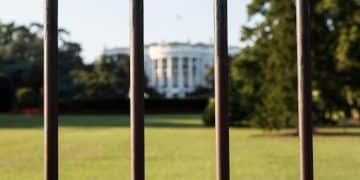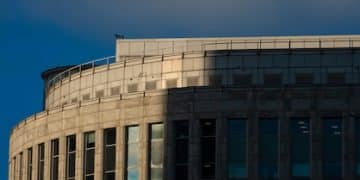Will the Fed Raise Interest Rates Again in Early 2025? Experts Predict

Will the Fed Raise Interest Rates Again in Early 2025? Experts Weigh In: Experts predict a potential rate hike in early 2025 due to persistent inflation and robust economic data, but the ultimate decision hinges on upcoming economic reports and global conditions.
The financial world is abuzz with speculation: Will the Fed Raise Interest Rates Again in Early 2025? Experts Weigh In, and the answer isn’t straightforward. Let’s delve into the factors influencing the Federal Reserve’s potential decision.
The Current Economic Landscape
Understanding the present economic situation is crucial to predicting the Federal Reserve’s next move. Several factors, including inflation rates, employment data, and global economic trends, play a significant role.
Inflationary Pressures Persist
Despite previous efforts to curb inflation, price increases have remained stubbornly persistent. This sticky inflation is causing concern among policymakers.
Strong Employment Data
The labor market continues to show strength, with low unemployment rates and consistent job creation. This complicates the Fed’s decision-making as tightening monetary policy could impact job growth.

Here are key indicators the Fed is closely monitoring that will influence future rates:
- Inflation Rate: The Consumer Price Index (CPI) and Personal Consumption Expenditures (PCE) are critical metrics.
- Unemployment Rate: Tracked monthly, it reflects the health of the labor market.
- GDP Growth: Provides insight into the overall economic expansion or contraction.
- Global Economic Conditions: International events can significantly impact domestic policy.
The current economic landscape presents a mixed bag of challenges and opportunities. Persistent inflation clashes with strong employment data, creating a complex scenario for the Federal Reserve. To sum up, the Fed’s decision will depend on how these competing forces are navigated to maintain economic stability.
The Fed’s Stance: A Delicate Balance
The Federal Reserve is tasked with maintaining price stability and maximizing employment. Balancing these dual mandates requires careful consideration of various economic indicators and potential policy impacts.
The Fed’s primary tools for managing the economy are:
- Federal Funds Rate: The target rate that banks charge each other for overnight lending.
- Quantitative Tightening (QT): Reducing the Fed’s balance sheet by not reinvesting maturing securities.
The Federal Reserve’s communication plays a pivotal role in shaping market expectations. Their forward guidance provides insights into their thinking and potential future actions.

Here are key considerations in the Fed’s decision-making process:
- Risk of Recession: Raising rates too aggressively could trigger an economic downturn.
- Impact on Businesses: Higher borrowing costs can stifle investment and hiring.
- Global Financial Stability: U.S. monetary policy can have ripple effects across the world.
The Fed will most likely hold interest rates steady in early 2025 if economic developments support such action, with rates possibly decreasing later in the year, according to a recent poll of more than 70 economists. The Federal Reserve is walking a tightrope, attempting to rein in inflation without causing undue harm to the economy. Therefore, the decisions made will have far-reaching consequences for businesses, consumers, and the global financial system.
Expert Opinions and Predictions
Financial experts and economists offer diverse perspectives on the likelihood of further rate hikes in early 2025. Their insights are based on extensive analysis and experience.
Diverging Views Among Economists
Some analysts believe that the Fed will need to raise rates again to fully tame inflation.
Market Sentiment and Expectations
Market participants closely watch economic data and Fed communications to anticipate policy changes.
Some economists suggest that the Fed may stay on hold if inflation shows signs of moderating and economic growth slows.
Predictions can vary widely based on differing economic models and assumptions. Understanding these varied perspectives is essential for investors. Experts often look to leading indicators to forecast a Fed move:
- The Yield Curve: An inversion can signal a potential recession.
- Housing Market Data: A slowdown in housing can indicate broader economic weakening.
- Consumer Confidence: Reflects household optimism about the economy.
Expert predictions on the Fed’s next move are far from uniform. The financial markets and broader economy are influenced significantly by these conflicting viewpoints, highlighting the uncertainty surrounding future monetary policy decisions.
Historical Context: Lessons from the Past
Examining past instances of Federal Reserve rate hikes can provide valuable context for understanding potential future actions. Analyzing the outcomes of similar policy decisions in the past can offer some insight into what might happen in 2025.
Previous Rate Hike Cycles
The Fed has historically used rate hikes to combat inflation and manage economic growth.
Economic Impact of Past Actions
Studying the consequences of past rate increases can help policymakers anticipate potential outcomes.
Past rate hikes always lead to a decrease in consumer spending, business investment, and overall economic growth. The Federal Reserve often looks back to guide current monetary policy.
- The 1980s: Aggressive rate hikes to combat double-digit inflation.
- The 1990s: Gradual rate increases to manage economic expansion.
Historical precedents underscore the notion that, whereas previous examples offer helpful insights, every economic context is distinct and calls for customized strategies. Therefore, historical context is a valuable tool for informing current policy decisions.
Global Economic Influences
The U.S. economy does not operate in isolation. Global economic conditions and international events can significantly influence the Federal Reserve’s policy decisions.
International Trade and Supply Chains
Disruptions in global trade and supply chains can impact inflation and economic growth in the U.S.
Geopolitical Risks
Political instability and conflicts in other parts of the world can create economic uncertainty.
The interconnected nature of the global economy means that events abroad can quickly affect domestic monetary policy. The strength of the U.S. Dollar, commodity prices (particularly oil), and policies of other central banks all come into play.
Examples of global events that could influence the Fed’s decisions include:
- European Central Bank (ECB) Policies: Actions taken by the ECB can impact global interest rates.
- China’s Economic Growth: A slowdown in China could affect global demand.
- Emerging Market Crises: Financial turmoil in emerging markets can create contagion risks.
Global economic situations exert a notable impact on the Federal Reserve’s decisions. Therefore, keeping abreast with international trends and events is essential for comprehending the possible course of monetary policy.
Strategies for Investors and Consumers
Given the uncertainty surrounding future interest rate movements, it’s essential for investors and consumers to develop strategies to protect their finances.
Investment Strategies
Diversifying portfolios and considering different asset classes can help mitigate risk.
Consumer Financial Planning
Managing debt and budgeting carefully can help consumers navigate potential interest rate changes.
Investors might consider dividend stocks, real estate, and bonds to diversify their portfolios. Consumers need to be more cautious. A few tips can help investors succeed:
- Fixed-Rate Mortgages: Protects against rising interest rates.
- High-Yield Savings Accounts: Benefits from higher rates.
- Debt Consolidation: Reduces the burden of high-interest debt.
Therefore, investors and consumers must be proactive in managing their funds in the face of possible interest rate increases. Strategic financial planning can help people and organizations weather whatever monetary environment is in store.
| Key Point | Brief Description |
|---|---|
| 📈 Inflation Trends | Persistent inflation pressures may prompt further rate hikes. |
| 💼 Employment Data | Strong job market complicates Fed’s decision-making. |
| 🌍 Global Influences | International events can significantly impact domestic policy. |
| 🏦 Expert Predictions | Economists’ views diverge, influencing market expectations. |
FAQ
▼
The Fed considers inflation, employment, GDP growth, and global economic conditions when deciding on interest rates, aiming to balance price stability and full employment.
▼
Global events, like trade disruptions or geopolitical risks, can impact U.S. inflation and growth, influencing the Fed’s monetary policy decisions.
▼
Investors can mitigate risk by diversifying portfolios, considering dividend stocks, real estate, and bonds to adapt to potential rate changes.
▼
Consumers can manage debt, budget carefully, opt for fixed-rate mortgages, and leverage high-yield savings accounts to navigate potential interest rate increases.
▼
The Federal Reserve’s dual mandate involves maintaining price stability and maximizing employment, requiring a careful balancing act when setting monetary policy.
Conclusion
In conclusion, the question of whether the Fed will raise interest rates again in early 2025 remains uncertain, hinging on a complex interplay of economic factors, expert opinions, and global events. Investors and consumers must stay informed and proactive to navigate the evolving financial landscape successfully.





